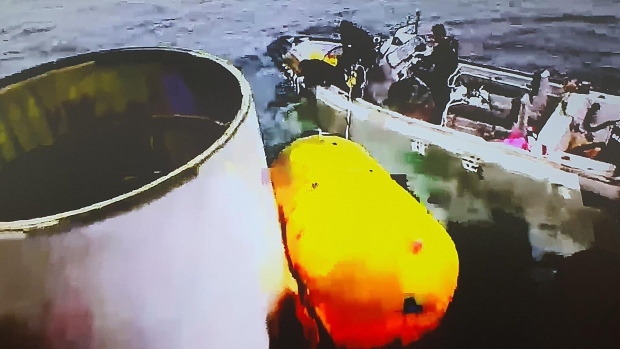Jul 4, 2023
South Korea Salvages North’s Spy Satellite in Intelligence Win
, Bloomberg News

(Bloomberg) -- South Korea salvaged a failed North Korean spy satellite from the sea, giving it a rare direct look at Pyongyang’s capabilities even as it concluded that the technology had little military value.
Officials on Wednesday said they concluded a 36-day salvage operation that deployed ships, aircraft and deep-sea divers to search for a rocket that was launched on May 31 but failed a few minutes into flight before crashing in international waters in the Yellow Sea. The salvage operation will likely end up being the most significant by the outside world on a North Korean rocket.
“Through this operation, major parts of North Korea’s space launch vehicle and satellite were recovered, and after careful analysis by American and South Korean experts, it was determined that they had no military efficacy as reconnaissance satellites,” South Korea’s Joint Chiefs of Staff said in a statement.
Experts said the recovered pieces still could provide information about the secretive state’s rocket program and give clues about possible sanctions violations in the procurement of its components.
The first stage of the rocket North Korea dubbed “Chollima-1,” in reference to a mythological winged horse, had a successful burn and is suspected to have used liquid-fuel engines, weapons experts said. Kim Jong Un’s regime has also deployed those engines in its most powerful intercontinental ballistic missiles designed to deliver nuclear warheads to the US mainland.
The rocket failed when the second stage engine did not ignite, North Korea said. The third stage contained the spy satellite. Its recovery is likely to provide information on the resolution of a camera that it carried.
Last month South Korea released photos of a 14.5-meter (48 feet) portion of the North Korean rocket. The two pieces it recovered in waters about 70 meters deep were from the second stage and likely contained the engine that did not fire, weapons experts said.
How Kim Jong Un Is Building a Nuclear North Korea: QuickTake
Sejin Kwon, a professor of aerospace engineering at the Korea Advanced Institute of Science and Technology, said even though South Korea has discounted the technology of the salvaged satellite, the outside world shouldn’t underestimate North Korea.
“This is the very first spy satellite Pyongyang has launched, and shortcomings are understandable,” Kwon said. “Yet the fact that the North, which has no contacts with outside, has reached this level of space tech is worth appraising.”
He added that it’s a matter of time before North Korea raises its game with reconnaissance, “since they have no other choice.”
David Schmerler, a senior research associate at the James Martin Center for Nonproliferation Studies, said if North Korea can launch and place an imaging satellite into orbit, it would likely use those images to refine its targeting list.
North Korea has said it wants to use spy satellites to keep an eye on military facilities in South Korea and Japan, where the US positions tens of thousands of military personnel.
North Korea is barred by United Nations Security Council resolutions from conducting ballistic missile tests, but Pyongyang has long claimed it’s entitled to a civilian space program for satellite launches. The US and its partners have warned that technology derived from North Korea’s space program could be used to advance its ballistic missiles.
Under Kim, North Korea has been increasing the domestic technology and components that go into its newest array of missiles. The country still needs the outside world for certain materials and components, which it is barred from acquiring under global sanctions to punish it for its pursuit of nuclear weapons and ballistic missiles to deliver warheads.
--With assistance from Shinhye Kang.
(Updates with analyst comment starting in eighth paragraph.)
©2023 Bloomberg L.P.





